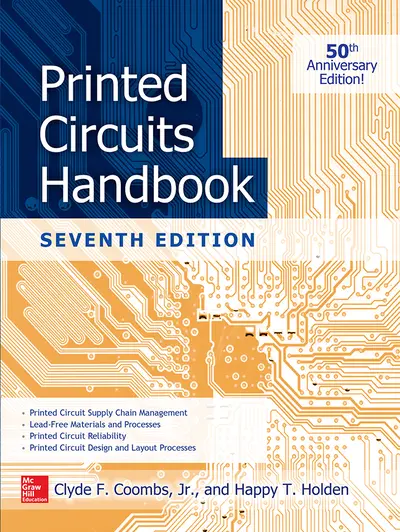My Account Details

ISBN10: 0071833951 | ISBN13: 9780071833950

Step 1 . Download Adobe Digital Editions to your PC or Mac desktop/laptop.
Step 2. Register and authorize your Adobe ID (optional). To access your eBook on multiple devices, first create an Adobe ID at account.adobe.com. Then, open Adobe Digital Editions, go to the Help menu, and select "Authorize Computer" to link your Adobe ID.
Step 3. Open Your eBook. Use Adobe Digital Editions to open the file. If the eBook doesn’t open, contact customer service for assistance.
Publisher's Note: Products purchased from Third Party sellers are not guaranteed by the publisher for quality, authenticity, or access to any online entitlements included with the product. The Most Complete and Widely Used Guide to Printed Circuits, Now Updated and Thoroughly Revised The Printed Circuits Handbook has served as the definitive source for coverage of every facet of printed circuit boards and assemblies for 50 years. And now, for the first time anywhere, the new edition of this essential guide provides time-saving tools for success in the area of printed circuit supply chain management, including an entire new section on the elements of design, supplier identification and qualification, process control, product acceptance processes, and quality and reliability specification and assurance. Written by a team of experts from around the world, this encyclopedic resource has been thoroughly revised and expanded to include the latest printed circuit tools and technologies – from design to fabrication. Hundreds of illustrations and charts demonstrate key concepts, and valuable tables provide quick and easy access to essential information. This new edition of the most trusted guide to printed circuits includes: Introduction to Printed Circuits Supply Chain Management Lead-Free Materials and Processes Engineering and Design of Printed Circuits Base Materials for All Applications Fabrication Processes High Density Interconnection Bare Board Testing Assembly Processes Soldering Materials and Processes Non-Solder Interconnection Quality Specification and Assessment Reliability Prediction and Assessment Assembly Testing Repair and Rework Flexible Circuits And Much More
Part 1: Printed Circuit Technology Drivers
Chapter 1. Electronic Packaging and High-Density Interconnectivity Clyde F. Coombs, Jr., and Happy T. Holden 3
1.1 Introduction / 3
1.2 Measuring the Interconnectivity Revolution / 3
1.3 Hierarchy of Interconnections / 6
1.4 Factors Affecting Selection of Interconnections / 7
1.5 ICs and Packages / 9
1.6 Density Evaluations / 10
1.7 Methods to Increase PWB Density / 13
1.8 References / 18
Chapter 2. Types of Printed Wiring Boards Hayao Nakahara 19
2.1 Introduction / 19
2.2 Classification of Printed Wiring Boards / 19
2.3 Organic and Nonorganic Substrates / 21
2.4 Graphical and Discrete-Wire Boards / 21
2.5 Rigid and Flexible Boards / 22
2.6 Graphically Produced Boards / 22
2.7 Molded Interconnection Devices / 27
2.8 Plated-Through-Hole Technologies / 27
2.9 Summary / 30
2.10 References / 30
Part 2: Managing the Printed Circuit Supply Chain
Chapter 3. Basics of Printed Circuit Supply Chain Management Tim Rodgers 33
3.1 Introduction / 33
3.2 General Business Considerations / 34
3.3 Contract Manufacturers / 35
3.4 Criteria for Evaluating Suppliers / 35
3.5 Supplier Selection Criteria Example / 41
Chapter 4. Design for Manufacturability Tim Rodgers 43
4.1 General Principles / 43
4.2 PCB/PCA Pricing Models / 44
4.3 Process Cost Drivers / 49
4.4 Production Yield and Design for Manufacturability / 51
4.5 DFM Complexity Models / 59
Chapter 5. Manufacturing Information, Documentation, Formatting, and Exchange Happy T. Holden 63
5.1 Introduction / 63
5.2 Manufacturing Information / 64
5.3 Fabrication Information Exchange / 68
5.4 Data Exchange Formats / 73
5.5 Initial Design Review / 86
5.6 Design Input / 94
5.7 Design Analysis and Review / 99
5.8 Acknowledgments / 99
5.9 References / 100
Chapter 6. Supplier Selection and Qualification Tim Rodgers 101
6.1 Introduction / 101
6.2 Evaluating Suppliers / 102
6.3 Supplier Selection / 113
6.4 Supplier Qualification / 114
Chapter 7. Process Control, Monitoring, and Incoming Inspection Tim Rodgers 117
7.1 Introduction / 117
7.2 Process Capability and Process Control / 117
7.3 Process Monitoring and Troubleshooting / 122
7.4 Assessing a PCB Fabricators Capability / 122
7.5 Testing and Inspection / 156
7.6 Incoming Inspection / 158
Chapter 8. Product Acceptance and Feedback Tim Rodgers 159
8.1 Introduction / 159
8.2 Design Qualification / 159
8.3 Incoming Inspection and Lot Acceptance / 160
8.4 Supplier Performance Management / 162
8.5 Business Reviews / 165
8.6 Strategic Supplier Management / 167
Part 3: Materials
Chapter 9. Introduction to Base Materials Edward Kelley and Douglas Trobough 171
9.1 Introduction / 171
9.2 Grades and Specifications / 171
9.3 Properties Used to Classify Base Materials / 178
9.4 Types of FR-4 / 184
9.5 Laminate Identification Scheme / 185
9.6 Prepreg Identification Scheme / 186
9.7 Laminate and Prepreg Manufacturing Processes / 189
9.8 References / 195
Chapter 10. Base Material Components Edward Kelley and Douglas Trobough 197
10.1 Introduction / 197
10.2 Other Resin Systems / 201
10.3 Legislative Issues / 203
10.4 Additives / 207
10.5 Reinforcements / 209
10.6 Conductive Materials / 217
10.7 References / 224
Chapter 11. Properties of Base Materials Edward Kelley and Douglas Trobough 225
11.1 Introduction / 225
11.2 Thermal, Physical, and Me
Need support? We're here to help - Get real-world support and resources every step of the way.